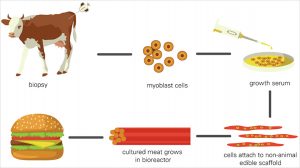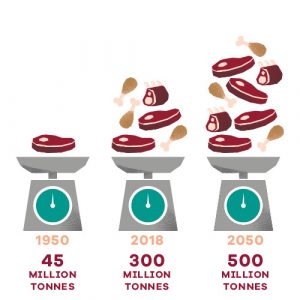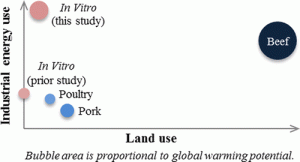Beatrix Junghardt

Figure 21.1 – Illustration of cultured meat, source: https://ideas.ted.com/are-you-ready-to-eat-meat-that-was-grown-in-a-lab-and-not-at-a-farm/
Cultured Meat, In-Vitro Meat, Clean Meat. Those are all names for meat, which is produced in a laboratory but can’t really be differentiated from real meat. This revolutionary discovery could solve many of our current problems and could have an impact on animal welfare, the environment and food security. But can this lab-grown meat really solve more problems than it creates? In the following blog post, different aspects about cultured meat are illustrated and discussed.
What is cultured meat?
Cultured meat is produced by removing stem cells from an animal, this process is said to be painless for the animal. Stem cells are cells, which don’t have a specific function but under the influence of certain hormones, they develop into specific cells. In the case of cultured meat, the stem cells differentiate into muscle cells. Through bioengineering techniques, the cells grow during four to six weeks in a medium, also called bioreactors, consisting of nutrient liquid, oxygen and warmth to a piece of meat.
The challenge in this process is to find a medium which is free from animal ingredients and also cost effective. There were mediums which contained serum of calves but these days there are good plant based alternatives, what makes the method morally more acceptable. After this short and very efficient process, a piece of meat is formed that looks, tastes and has the same nutritional value as livestock meat.

Figure 21.2 – Process of cultured meat, source: https://www.six-group.com/exchanges/issuers/services/tensid_news_de.html?id=b7a85393
How can cultured meat be an environment problem solver?
Livestock is responsible for 14.5% of the greenhouse gas emissions, 26% of land is used for livestock grazing and 33% of the croplands are used for livestock feeding. Worldwide, 73% of antimicrobials, mainly antibiotics, are consumed by livestock. To produce 15 grams of meat, approximately 100g of plants are used and the production of 1kg of beef needs 15’000 l of water.
2019 the world population contained about 7.75 billion people. In 2050, estimations of the UN show, that there will be 9.7 billion people. World population growth won’t stop, there will be more and more people to feed. Through climate change, agriculture gets less predictable and makes it difficult to preserve food supply stability.

Figure 21.3 – Meat consumption development, source: https://www.slowfood.com/what-we-do/themes/slow-meat/
If we could replace animal meat with artificial meat, which tastes exactly the same, looks the same and contains the same nutrients, we wouldn’t need to strain the environment that much. In addition to that, we could prevent antibiotic resistance because much less antibiotics would end up in the environment.
It seems as if cultured meat only has positive impacts. But this isn’t fully the case, there is also another side to the story.
A study showed that cultured meat would reduce greenhouse gas emissions by 78-98%, land use by 99% and energy use by 45%. Those numbers are quite big and would definitely have an impact on our global situation.
Further studies showed that those numbers aren’t as high as expected. Some recent research show that over long-term, the environmental impact of this “clean meat” could even be worse than the livestock impact (see figure 3). There are high costs for producing cultured meat, it requires an expensive and high energy consuming infrastructure. Land and water use can be reduced but the energy use can be increased by this method compared to livestock meat production. So according to those studies cultured meat needs to be discussed and evaluated very critically.

Figure 21.4 – Comparison cultured meat and livestock meat, source:https://pubs.acs.org/doi/abs/10.1021/acs.est.5b01614?journalCode=esthag
Nevertheless, cultured meat could be a solution for many problems by its very efficient method to produce food without using much land, antibiotics or croplands for animal nutrition. Even though cultured meat isn’t as clean as predicted, it would generate a state of utopia where everyone could eat as much meat as desired without taking advantage of resources or draining the environment.
Can cultured meat really be a game changer?
To answer this question, we have to take a look at the needs of the population and not only at the progress in technology or science.
The stakeholders who would be interested in a possibility of replacing livestock meat with cultured meat in a supermarket aren’t vegetarians or vegans. There are enough products for vegetarians or vegans to get all the necessary nutrients. The challenge in this project is to develop something which could be e good or even perfect replacement for meat and not only to create another option for vegetarians or vegans.
In countries with high meat consumption, health problems are very common. Meat is not very healthy when excessively consumed and leads to diseases. This problem can’t be solved by cultured meat because it has the same composition as livestock meat. By creating an option which allows the population to continue their meat consumption behavior, aren’t we just avoiding the fact that at one point we need to change our behavior? It is hard to understand why people can’t just change their behavior or why economists and politicians can’t tighten import regulations or change the consumer behavior by regulations. An average person is clearly just not interested to resign in buying meat when having the financial mediums and no alternatives are provided. By creating cultured meat, people are willing to accept the opportunity in doing something for the environment because they don’t lose anything. The taste stays the same, they don’t have to make an effort and maybe at one point they pay the same price or even less for a piece of meat.
The stakeholders who have to get convinced are meat-lovers and people who can’t imagine a life without meat. But how can those people get convinced, if the price of In-Vitro meat is more expensive than real meat or when it’s not even proven yet how environmentally friendly the process really is? Nevertheless, this is a question, which can only be answered with more research about the positive impacts. Until now it is only clear that there is a high potential to be ecological and more responsible.
The technology is ready, the science is almost there, it’s all about regulation. Solutions need to be found for the pricing problem and also to integrate the product in a way that it gets fully accepted. The information flow is very important in getting people to accept the product. If people get informed about how the meat was produced and about the positive impacts, the integration progress of the product won’t be a problem. It’s about policies and what image the product gets. If the cultured meat really gets to be in great demand, it could easily replace livestock meat.
Another unsolved question is what would happen with the farmers, butchers and other workers who can’t survive without the meat business? By integrating cultured meat, new workplaces are created but also other jobs aren’t necessary anymore. This will also be a topic which people would have to deal with
From a moral perspective, we should consider the fact that it might not be ethically correct to produce meat. Meat originates from a living animal and even though not a whole animal is grown in a lab but only tissue and cells, it might not be ethically correct to create flesh and blood. Some people may not accept the product because of this.
Additionally, the health consequences of the product aren’t clear yet. Until now it seems as if cultured meat has the same impacts as livestock meat, but it’s not proven and still not clear if one can trust this product.
If cultured meat really could be a game changer is controversial, but it is clear that this innovation could be revolutionary and that this is definitely a step in the right direction to safe our planet. Cultured meat could solve many problems but could also create new problems. We’ll see if there’s going to be a product which can handle all the problems and change the environmental situation.
What is to be expected?
«Fifty years hence, we shall escape the absurdity of growing a whole chicken in order to eat the breast or wing by growing these parts separately under a suitable medium.»
-Winston Churchill, 1931
This statement shows that many years ago it was already predictable that meat consumption would someday need to be changed. This is exactly what is happening at the moment and what will shape our future.
Cultured meat is not yet available for the wide market. Presumably the product will appear in specific restaurants in the next three years and will need three to four more years until it appears in supermarkets and can be included in the everyday life. How it then will be included and accepted by consumers remains an important aspect of the process. Affordable prices and profitability for producers could lead to a successful kick-start on the market.
«Swissveg begrüsst alle Anstrengungen, die dazu führen können, dass weniger Tiere für die menschliche Ernährung ausgebeutet werden müssen.»
-Renato Pichler, Geschäftsführer Swissveg
«Es ist eine echte Alternative für jene Konsumenten, die heute aus enthischen oder ökologischen Gründen ganz oder teilweise auf Fleisch verzichten.»
-Fabian Vetsch, Sprecher Bell Food AG
Those quotes show that the population of Switzerland and its companies are willing to participate in this process. Switzerland (e.g. Bell Food AG) invests money in start-ups to accelerate the process of this meat replacement. This means that the population is open for this new era and is ready to invest in this process. There is still a long way to go and many problems to solve and questions to answer.
But it is definitely a long way worth taking to give back those 25% of the global surface which is now used for livestock production.
Cultured meat is a topic which leads to big discussions and one has to build its own opinion about the pros and cons. To close this blog post I’d like to include my own opinion.
Before I started my research about this topic, I didn’t know much about it and couldn’t understand why and how this innovation could solve that many problems. Furthermore I couldn’t understand why that much money is invested in a project where the consequences or impacts aren’t even fully researched yet. After reading some articles I changed my mind very quickly. I still find it a risky project and nobody really knows where it leads but in my opinion it could solve more problems than it creates. So yes, cultured meat is morally and environmentally acceptable. It is our future, we need alternatives and need to find ways to save our planet even though a new revolutionary discovery like this is scary and seems to be impossible in the beginning.
References
- https://www.vier-pfoten.ch/kampagnen-themen/themen/ernaehrung/fleisch-der-zukunft
- https://medicalxpress.com/news/2019-11-cultured-meat-problems.html
- https://www.new-harvest.org/environmental_impacts_of_cultured_meat
- https://www.futurefood.org/in-vitro-meat/index_en.php
Videos
- https://www.srf.ch/news/schweiz/alternativen-zu-fleisch-fleisch-aus-dem-labor-kommt-in-drei-jahren-auf-den-markt
- https://www.youtube.com/watch?v=VYXw_-vJFBA
Media Attributions
- ted_burger_normal
- cultured meat 749px
- slow-meat_bilancia
- es-2015-01614h_0007